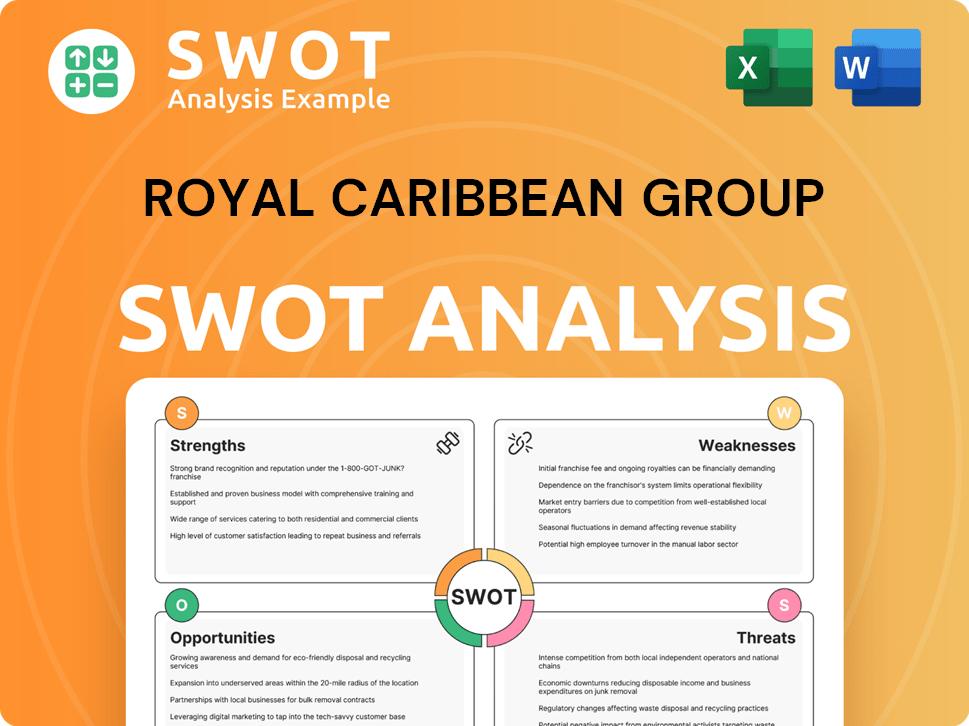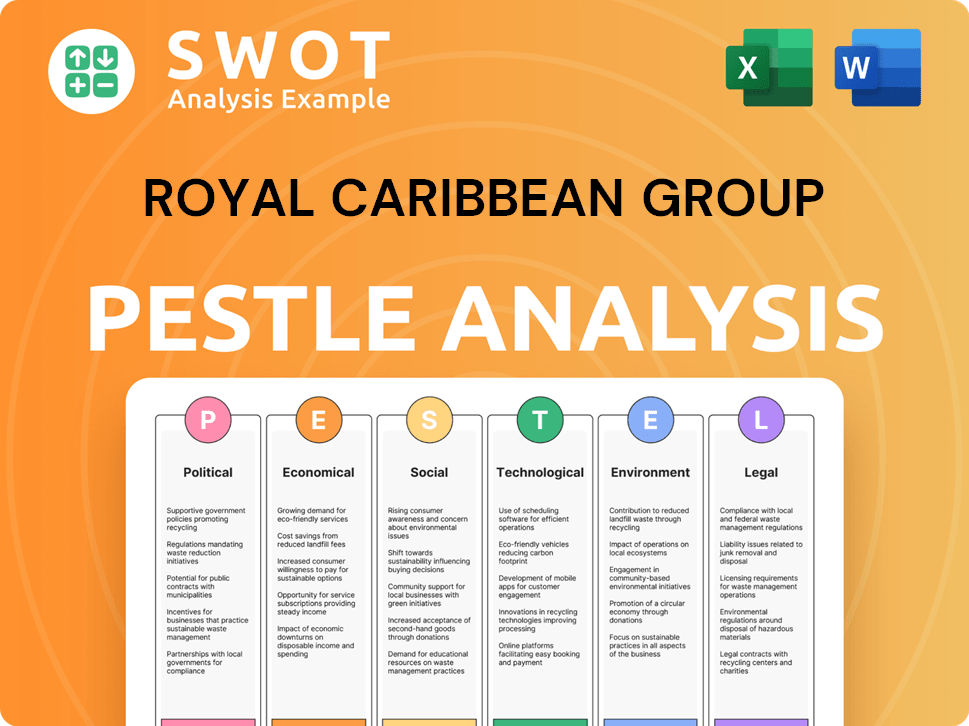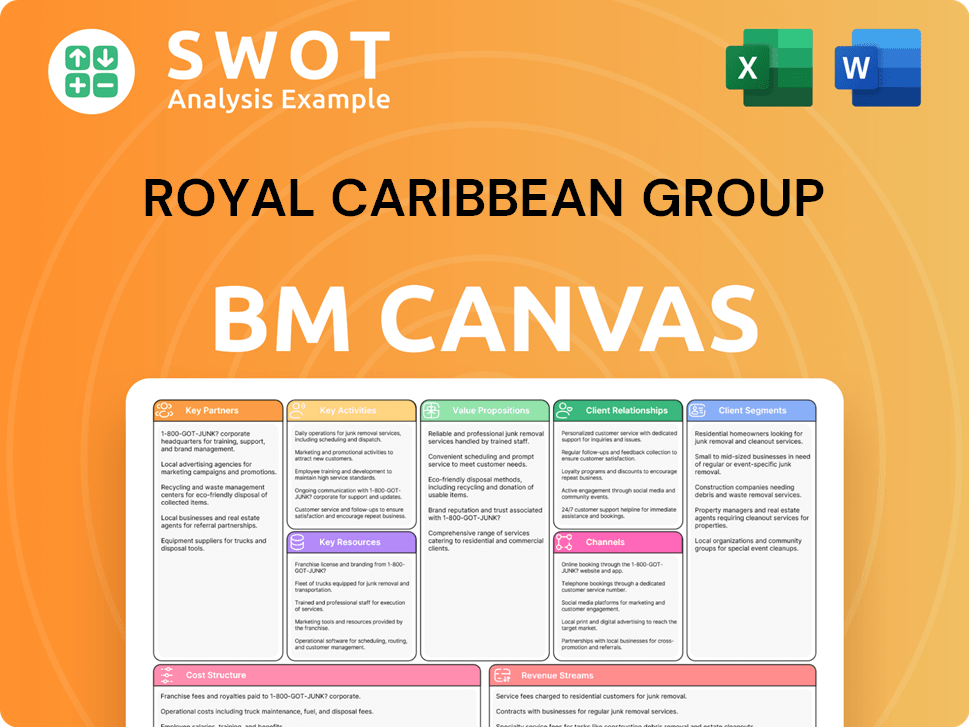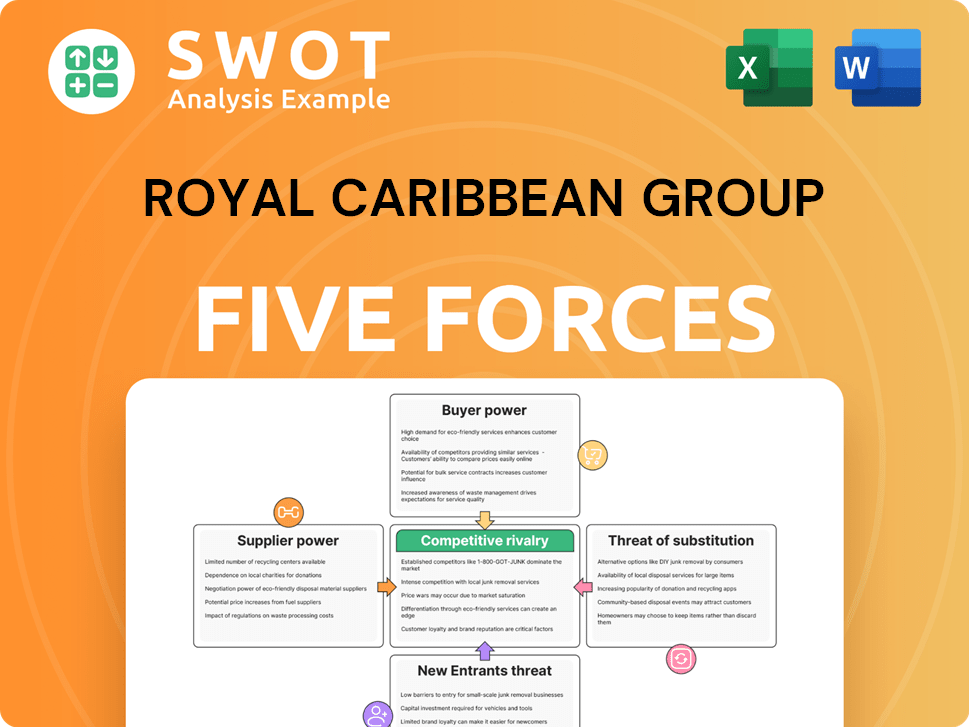Royal Caribbean Group Bundle
Who Really Steers the Ship at Royal Caribbean Group?
Delving into 'Who Owns Royal Caribbean Group' is essential for understanding the cruise giant's trajectory and its impact on the global tourism landscape. Royal Caribbean Group's ownership structure, from its inception in 1968 as Royal Caribbean Cruise Line, has profoundly shaped its strategic decisions and market position. This analysis will uncover the key players and their influence on this leading cruise line.

Understanding Royal Caribbean ownership is crucial for investors and industry observers alike. From its roots to its current status as a publicly traded company, the evolution of Royal Caribbean Group's shareholder base provides valuable insights. This exploration will examine the major owners of Royal Caribbean, its corporate structure, and the forces shaping its future, including its Royal Caribbean Group SWOT Analysis. Knowing who is the CEO of Royal Caribbean Group and the Royal Caribbean Group leadership team is important to understand the company's direction.
Who Founded Royal Caribbean Group?
The genesis of Royal Caribbean Group, formerly known as Royal Caribbean Cruises Ltd. (RCCL), traces back to 1968, when it was established by a consortium of three Norwegian shipping companies. These were Anders Wilhelmsen & Co., Gotaas-Larsen, and I.M. Skaugen & Co. This collaborative approach was a strategic move to enter the burgeoning cruise market, leveraging the maritime expertise and capital of the founding entities.
The initial ownership structure of Royal Caribbean, though not fully detailed in public records from that era, was a joint venture. This structure indicates a shared vision and distributed ownership among the founding companies. The partnership allowed them to pool resources and expertise, crucial for launching the company's first ship, the Song of Norway, in 1970. Anders Wilhelmsen & Co. played a significant role as a key stakeholder from the beginning.
These founding companies provided the essential capital and strategic direction necessary for Royal Caribbean's early operations. Their combined experience in shipping and maritime operations was crucial in the design and launch of the company's initial fleet. Agreements between the partners likely covered capital contributions, operational responsibilities, and profit-sharing arrangements. There is no widely available information regarding significant early ownership disputes or buyouts, indicating a relatively stable collaborative foundation during the company's early stages. The founders' vision centered on creating a modern cruise experience, setting themselves apart through purpose-built ships and a focus on the Caribbean market, which influenced the initial allocation of control and investment among the partners.
The initial ownership of Royal Caribbean was a joint venture among three Norwegian shipping companies. Their combined expertise in maritime operations and shipping provided a strong foundation for the cruise line. The early focus was on building a modern cruise experience, differentiating itself through purpose-built ships and a focus on the Caribbean market. For anyone interested in the financial journey of the company, further insights can be found in the Growth Strategy of Royal Caribbean Group.
- The founding companies were Anders Wilhelmsen & Co., Gotaas-Larsen, and I.M. Skaugen & Co.
- The joint venture structure facilitated shared resources and expertise.
- The initial focus was on the Caribbean market.
- The first ship, the Song of Norway, launched in 1970.
Royal Caribbean Group SWOT Analysis
- Complete SWOT Breakdown
- Fully Customizable
- Editable in Excel & Word
- Professional Formatting
- Investor-Ready Format

How Has Royal Caribbean Group’s Ownership Changed Over Time?
The evolution of Royal Caribbean Group's ownership is marked by its Initial Public Offering (IPO) in 1993, a pivotal moment that transformed the company from private to public. This shift, which listed the company on the New York Stock Exchange under the ticker symbol RCL, allowed Royal Caribbean to raise capital for expansion. The IPO was a crucial step in the company's growth trajectory, facilitating investments in new ships and fleet upgrades. Knowing Marketing Strategy of Royal Caribbean Group can help you understand how the company has grown over the years.
Following the IPO, Royal Caribbean's ownership structure has largely transitioned towards institutional investors. These entities, including mutual funds and index funds, now hold a significant portion of the company's shares. As of early 2025, major institutional shareholders such as The Vanguard Group, Inc. and BlackRock, Inc. are prominent, often holding substantial percentages of outstanding shares. This dispersed ownership structure indicates that no single entity has a controlling interest, reflecting the company's status as a publicly traded entity.
| Shareholder | Approximate Percentage of Shares (as of March 31, 2025) | Notes |
|---|---|---|
| The Vanguard Group, Inc. | Over 10% | Major institutional investor |
| BlackRock, Inc. | Around 8-9% | Significant institutional holder |
| Capital Research Global Investors | Varies | Institutional investor |
| State Street Corp | Varies | Institutional investor |
The shift in ownership has influenced Royal Caribbean's strategic direction, with a focus on enhancing shareholder value. This includes fleet expansion, cost efficiencies, and strategic acquisitions. The Wilhelmsen family, although they held a significant stake post-IPO, has seen their proportional ownership diluted over time due to subsequent share offerings and company growth. The 2024 annual report provides the most recent figures on major shareholders and their respective percentages, offering insights into the current ownership landscape.
Royal Caribbean Group transitioned from private to public ownership through its 1993 IPO.
- Institutional investors, like Vanguard and BlackRock, are now major shareholders.
- The company's strategy is influenced by the need to increase shareholder value.
- The latest ownership details are available in the 2024 annual report.
- The company is publicly traded.
Royal Caribbean Group PESTLE Analysis
- Covers All 6 PESTLE Categories
- No Research Needed – Save Hours of Work
- Built by Experts, Trusted by Consultants
- Instant Download, Ready to Use
- 100% Editable, Fully Customizable

Who Sits on Royal Caribbean Group’s Board?
The Board of Directors of Royal Caribbean Group, as detailed in the 2024 proxy statement, oversees the company's strategic direction and represents shareholder interests. The board includes a mix of independent directors and those with connections to major stakeholders. The structure typically includes a Chairman, a Lead Independent Director, and other independent directors, alongside the President and CEO. The composition of the board emphasizes independent oversight, reflecting modern corporate governance practices. The board's role is crucial in ensuring corporate accountability and safeguarding shareholder interests, especially given the dispersed ownership among many institutional and public shareholders. The independent directors play a vital role in overseeing management.
The board's composition aims for a balance of industry experience, financial acumen, and independence. The board members work collaboratively, with input from executive leadership. The company's approach to governance is designed to maintain a stable relationship between management, the board, and its major shareholders. This structure promotes a democratic voting process among shareholders, making the collective power of institutional investors significant. The board's structure reflects the company's commitment to good corporate governance and shareholder value. For information on the competitive landscape, consider reading Competitors Landscape of Royal Caribbean Group.
| Board Member | Title | Affiliation |
|---|---|---|
| Richard D. Fain | Chairman of the Board | Royal Caribbean Group |
| Jason Liberty | President and CEO | Royal Caribbean Group |
| Bill L. Allen | Lead Independent Director | Independent |
Royal Caribbean Group operates under a one-share-one-vote structure for its common stock. This means each share generally entitles its holder to one vote on shareholder matters. There are no publicly disclosed dual-class shares or special voting rights. This structure ensures a democratic voting process. The company has not been subject to high-profile proxy battles in recent years.
The Board of Directors is composed of independent and stakeholder-connected members, ensuring diverse perspectives. The company uses a one-share-one-vote structure, promoting shareholder democracy.
- The board includes a Chairman, Lead Independent Director, and other independent directors.
- The company's governance structure aims for stability and accountability.
- The board's composition reflects modern corporate governance best practices.
- The company's governance structure promotes a democratic voting process.
Royal Caribbean Group Business Model Canvas
- Complete 9-Block Business Model Canvas
- Effortlessly Communicate Your Business Strategy
- Investor-Ready BMC Format
- 100% Editable and Customizable
- Clear and Structured Layout

What Recent Changes Have Shaped Royal Caribbean Group’s Ownership Landscape?
Over the past few years (2022-2025), the ownership structure of Royal Caribbean Group has seen continued evolution, shaped by market dynamics and strategic financial decisions. Share buyback programs, when implemented, can reduce the number of outstanding shares, increasing the proportional ownership of remaining shareholders. Conversely, secondary offerings, though less frequent for established public companies, would dilute existing ownership. Details on specific buyback programs or secondary offerings in the 2024-2025 period would be found in the company's latest SEC filings.
A key event impacting ownership was the full acquisition of Silversea Cruises in 2020, which involved a cash and stock transaction. This could have slightly altered the shareholder base by bringing in new shareholders from the acquired entity, although it was primarily a strategic business move. Leadership changes, such as shifts in CEO roles, can sometimes correlate with changes in institutional investor confidence or strategic direction, indirectly influencing ownership through trading activity. The company is a publicly traded entity, with its ownership predominantly held by institutional investors and individual shareholders. You can find more information about the company's financial performance and strategic direction in a dedicated article about Royal Caribbean Group.
| Metric | Details | Source/Date |
|---|---|---|
| Stock Symbol | RCL | NYSE |
| Market Capitalization (Approximate) | Varies, check latest data | Early 2025 |
| Institutional Ownership (Approximate) | Typically a significant percentage | Early 2025 |
Industry trends also play a role. There's a general trend of increasing institutional ownership across many public companies, including those in the cruise sector, as index funds and ETFs grow. This leads to further dilution of individual founder or family stakes over time, even if those families retain significant wealth from their initial holdings. The rise of activist investors, while not a dominant force in Royal Caribbean Group's recent history, is an ongoing trend that could potentially influence ownership dynamics in the future, pushing for operational changes or governance reforms. As of early 2025, there have been no major public statements by the company or analysts indicating an imminent privatization or a significant shift in its public listing status.
The major owners of Royal Caribbean are primarily institutional investors. These include large investment firms, mutual funds, and other financial institutions. The exact percentage held by each varies and is subject to change.
Yes, Royal Caribbean Group (RCL) is a publicly traded company. Its shares are listed on the New York Stock Exchange (NYSE), allowing investors to buy and sell shares on the open market.
The CEO of Royal Caribbean Group is a key figure in the company's leadership. The current CEO's name and tenure can be found in the most recent company filings or official announcements.
To invest in Royal Caribbean Group, you would typically purchase shares of its stock (RCL) through a brokerage account. Researching the company's financial information and consulting with a financial advisor is recommended.
Royal Caribbean Group Porter's Five Forces Analysis
- Covers All 5 Competitive Forces in Detail
- Structured for Consultants, Students, and Founders
- 100% Editable in Microsoft Word & Excel
- Instant Digital Download – Use Immediately
- Compatible with Mac & PC – Fully Unlocked

Related Blogs
- What are Mission Vision & Core Values of Royal Caribbean Group Company?
- What is Competitive Landscape of Royal Caribbean Group Company?
- What is Growth Strategy and Future Prospects of Royal Caribbean Group Company?
- How Does Royal Caribbean Group Company Work?
- What is Sales and Marketing Strategy of Royal Caribbean Group Company?
- What is Brief History of Royal Caribbean Group Company?
- What is Customer Demographics and Target Market of Royal Caribbean Group Company?
Disclaimer
All information, articles, and product details provided on this website are for general informational and educational purposes only. We do not claim any ownership over, nor do we intend to infringe upon, any trademarks, copyrights, logos, brand names, or other intellectual property mentioned or depicted on this site. Such intellectual property remains the property of its respective owners, and any references here are made solely for identification or informational purposes, without implying any affiliation, endorsement, or partnership.
We make no representations or warranties, express or implied, regarding the accuracy, completeness, or suitability of any content or products presented. Nothing on this website should be construed as legal, tax, investment, financial, medical, or other professional advice. In addition, no part of this site—including articles or product references—constitutes a solicitation, recommendation, endorsement, advertisement, or offer to buy or sell any securities, franchises, or other financial instruments, particularly in jurisdictions where such activity would be unlawful.
All content is of a general nature and may not address the specific circumstances of any individual or entity. It is not a substitute for professional advice or services. Any actions you take based on the information provided here are strictly at your own risk. You accept full responsibility for any decisions or outcomes arising from your use of this website and agree to release us from any liability in connection with your use of, or reliance upon, the content or products found herein.